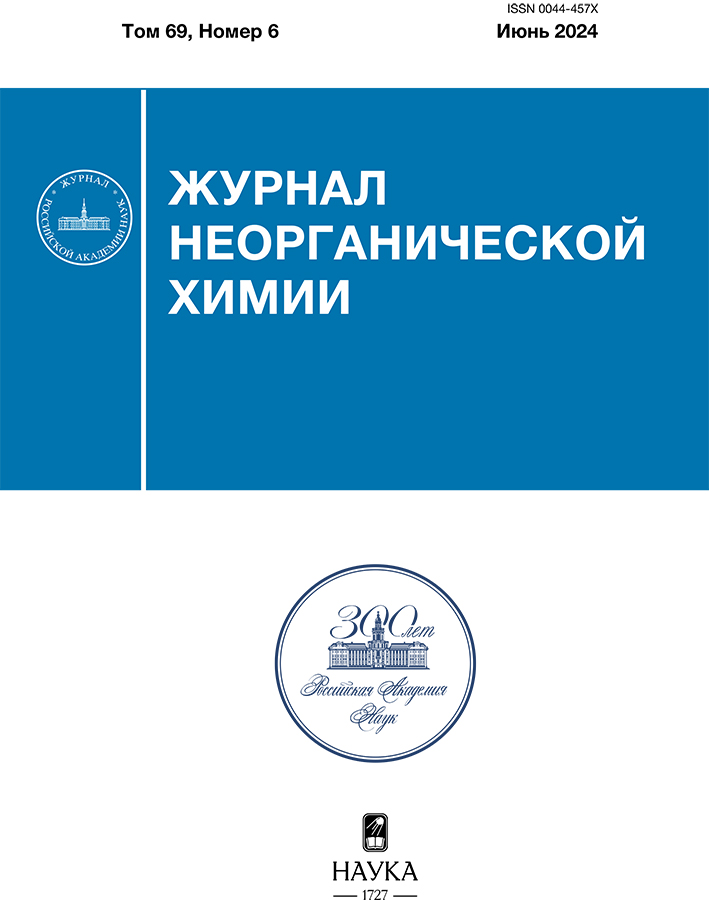Quantum‒Chemical Simulation of Molecular Hydrogen Abstraction from Magnesium Borohydride Diammoniate
- Autores: Zyubin A.S.1, Zyubina T.S.1, Kravchenko O.V.1, Solov’ev M.V.1, Vasiliev V.P.1, Zaitsev A.A.1, Shikhovtsev A.V.1,2, Dobrovol’sky Y.A.1,2
-
Afiliações:
- Federal Research Center for Problems of Chemical Physics and Medicinal Chemistry, Russian Academy of Sciences
- Hydrogen energy center of AFK “Sistema”
- Edição: Volume 69, Nº 6 (2024)
- Páginas: 853-865
- Seção: ТЕОРЕТИЧЕСКАЯ НЕОРГАНИЧЕСКАЯ ХИМИЯ
- URL: https://rjonco.com/0044-457X/article/view/666496
- DOI: https://doi.org/10.31857/S0044457X24060071
- EDN: https://elibrary.ru/XTHGDX
- ID: 666496
Citar
Texto integral
Resumo
Within the framework of the cluster approach using the 6‒31G* basis set and the hybrid density functional (B3LYP), we modeled successive abstraction of H2 from the complexes (Mg(BH4)2∙2NH3)2 and (Mg(BH4)2∙2NH3)4. It was found that the initial stage of dehydrogenation needs overcoming energy barriers ~ 1.5‒1.2 eV, which requires preheating, then the process can go on with energy release until about 10 wt % of H2 is extracted, for a higher degree of conversion, additional energy costs exceeding the combustion heat of H2 will be required when extracting more than 12.5 wt % of H2. Therefore, further dehydrogenation of this compound may turn out to be inexpedient from the energy point of view.
Texto integral
Sobre autores
A. Zyubin
Federal Research Center for Problems of Chemical Physics and Medicinal Chemistry, Russian Academy of Sciences
Autor responsável pela correspondência
Email: zyubin@icp.ac.ru
Rússia, Chernogolovka, 142432
T. Zyubina
Federal Research Center for Problems of Chemical Physics and Medicinal Chemistry, Russian Academy of Sciences
Email: zyubin@icp.ac.ru
Rússia, Chernogolovka, 142432
O. Kravchenko
Federal Research Center for Problems of Chemical Physics and Medicinal Chemistry, Russian Academy of Sciences
Email: zyubin@icp.ac.ru
Rússia, Chernogolovka, 142432
M. Solov’ev
Federal Research Center for Problems of Chemical Physics and Medicinal Chemistry, Russian Academy of Sciences
Email: zyubin@icp.ac.ru
Rússia, Chernogolovka, 142432
V. Vasiliev
Federal Research Center for Problems of Chemical Physics and Medicinal Chemistry, Russian Academy of Sciences
Email: zyubin@icp.ac.ru
Rússia, Chernogolovka, 142432
A. Zaitsev
Federal Research Center for Problems of Chemical Physics and Medicinal Chemistry, Russian Academy of Sciences
Email: zyubin@icp.ac.ru
Rússia, Chernogolovka, 142432
A. Shikhovtsev
Federal Research Center for Problems of Chemical Physics and Medicinal Chemistry, Russian Academy of Sciences; Hydrogen energy center of AFK “Sistema”
Email: zyubin@icp.ac.ru
Rússia, Chernogolovka, 142432; Chernogolovka, 142432
Y. Dobrovol’sky
Federal Research Center for Problems of Chemical Physics and Medicinal Chemistry, Russian Academy of Sciences; Hydrogen energy center of AFK “Sistema”
Email: zyubin@icp.ac.ru
Rússia, Chernogolovka, 142432; Chernogolovka, 142432
Bibliografia
- Schlapbach L., Zuttel A. et al. // Nature. 2001. V. 414. P. 353. https://doi.org/10.1038/35104634
- ZüttelA. et al. // Mater. Today. 2003. V. 6. P. 24. https://doi.org/10.1016/S1369-7021(03)00922-2
- Семененко К.Н., Шилкин С.П., Полякова В.Б. и др. // Изв. АН СССР. Сер. хим. 1975. № 4. С. 735.
- Коноплев В.Н., Силина Т.А. и др. // Журн. неорган. химии. 1985. Т. 30. С. 1125.
- Кравченко О.В., Кравченко С.Е., Семененко К.Н. и др. // Журн. общ. химии. 1990. Т. 60. С. 2641.
- Кравченко О.В., Хафизова Г.М., Бурдина К.П. и др. // Журн. общ. химии.1994. Т. 64. С. 6.
- Yang Y., Liu Y., Zhang Y. et al. // J. Alloys Compounds. 2014. V. 585. P.674. https://doi.org/10.1016/j.jallcom.2013.09.208
- Orimo S.-I., Nakamori Y., Eliseo J.R. et al. // Chem. Rev. 2007.V. 107. P. 4111. https://doi.org/10.1021/cr0501846
- Satyapal S., Petrovic J., Read C. et al. // Catal. Today. 2007. V. 120. P. 246. https://doi.org/10.1016/j.cattod.2006.09.022
- Lu J., Fang Z.Z., Sohn H.Y. et al. // Inorg. Chem. 2006. V. 45. P. 8749. https://doi.org/10.1021/ic060836o
- Zavorotynska O., El-Kharbachi A., Deledda S. et al. // Int. J. Hydrogen Energy. 2016. V. 41. P.14387. https://doi.org/10.1016/j.ijhydene.2016.02.015
- Klyukin I.N., Vlasova Y.N., Novikov A.S. et al. // Symmetry. 2021.V.13. P. 464. https://doi.org/10.3390/sym13030464
- Klyukin I.N., Novikov A.S., Zhdanov A.P. et al. // Polyhedron. 2020.V.187. P. 114682. https://doi.org/10.1016/j.poly.2020.114682
- Зюбин А.С., Зюбина Т.С., Кравченко О.В. и др. // Журн. неорган. химии. 2016. Т. 61. С. 767.
- Зюбин А.С., Зюбина Т.С., Кравченко О.В. и др. // Журн. неорган. химии. 2017. Т. 62. С. 305.
- Зюбин А.С., Зюбина Т.С., Кравченко О.В. и др. // Журн. неорган. химии. 2018. Т. 63. С. 190.
- Solovev M.V., Chashchikhin O.V., Dorovatovskii P.V. et al. // J. Power Sources. 2018. V. 377. P. 93. https://doi.org/10.1016/j.jpowsour.2017.11.090
- Soloveichik G., Her J.-H., Stephens P.W. et al. // Inorg. Chem. 2008. V. 47. P. 4290. https://doi.org/10.1021/ic7023633
- Guo Y., Wu H., Zhou W. et al. // J. Am. Chem. Soc. 2011. V. 133. P. 4690. https://doi.org/10.1021/ja1105893
- Yang Y.J., Gao M.X., Liu Y.F. et al. // Int. J. Hydrogen Energy. 2012. V.37.P.10733. https://doi.org/10.1016/j.ijhydene.2012.04.068
- Yang Y., Liu Y., Li Y. et al. // Chem. Asian J. 2013. V. 8. P. 476. https://doi.org/10.1002/asia.201200970
- Yang Y., Liu Y., Li Y. et al. // J. Phys. Chem. C. 2013. V. 117. P. 16326. https://doi.org/10.1021/jp404424m
- Jepsen L.H., Ley M.B., Filinchuk Y. et al. // Chem-Sus. Chem. 2015. V.8. P. 1452. https://doi.org/10.1002/cssc.201500029
- Paskevicius M., Jepsen L.H., Schouwink P. et al. // Chem. Soc. Rev. 2017. V. 46. P. 1565. https://doi.org/10.1039/c6cs00705h
- Yan Y., Dononelli W., Jorgensen M. et al. // Phys. Chem. Chem. Phys. 2020. V. 22. P. 9204. https://doi.org/10.1039/d0cp00158a
- Chen X., Yu X. et al. // J. Phys. Chem. C. 2012. V. 116. P. 11900. https://doi.org/10.1021/jp301986k
- Yuan P.-F., Wang F., Sun Q. et al. // Int. J. Hydrogen Energy. 2013. V. 38. P. 2836. https://doi.org/10.1016/j.ijhydene.2012.12.075
- Wang K., Zhang J.-G., Lang X.-Q. et al. // Phys. Chem. Chem. Phys. 2016. V. 18. P. 7015. https://doi.org/10.1039/C5CP06808H
- Chen X., Li R., Xia G. et al. // RSC Adv. 2017. V. 7. P. 31027. https://doi.org/10.1039/c7ra05322c
- Chen X., Zou W., Li R. et al. // J. Phys. Chem. C. 2018. V. 122. P. 4241. https://doi.org/10.1021/acs.jpcc.8b00455
- Зюбин А.С., Зюбина Т.С., Кравченко О.В. и др. // Журн. неорган. химии. 2022. Т. 67. С. 1425.
- Becke A.D. et al. // J.Chem.Phys. 1993. V.98. P. 5648. https://doi.org/10.1063/1.464913
- Johnson B.J., Gill P.M.W., Pople J.A. et al. // J. Chem. Phys. 1993. V. 98. P. 5612.
- Gaussian 09, Revision B.01. Gaussian, Inc., Wallingford CT, 2010. https://doi.org/10.1063/1.464906
Arquivos suplementares



















